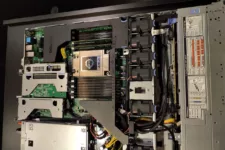This week I’m at AMD’s launch for their next generation CPU and GPU products. Intel has yet to field a competitive GPU solution and given AMD and NVIDIA are running hard against each other I have my doubts that Intel can catch either from behind and, without IDF, I don’t think they can pull an iPhone and dramatically change the battlefield either. On the CPU side, particularly for servers, AMD has placed Intel between a rock and a hard place because any competitive move Intel makes will hurt Intel, they basically have a lose/lose choice and, strategically (a word I’ve come to find Intel has lost the ability to even spell) they are likely screwed.
Let me explain.
Socket Wars
What AMD showcases at this launch event was their single socket next generation Epyc processor out performing a twin socket top of market Xeon (Intel) solution. Intel is basically given a bad choice between two outcomes because their twin socket solution is substantially more expensive than AMD’s single socket solution. This means they either have to dramatically drop the price of their dual socket solution allowing it to compete with AMD on price while holding performance, or they have to create their own price competitive single socket solution. But, in this latter case, that means they would sell half as many processors per server taking an ugly hit to both their top and bottom lines. In fact, either response would mean a huge hit on top and bottom lines.
But the second choice as an additional problem, unlike AMD which outsources manufacturing to firms like Global Foundry, Intel has to keep their FAB (manufacturing plant) operating at or near capacity or they take a huge expense hit (a factory that is under utilized is an expense hole because, regardless of whether it is building anything, you still have massive fixed expenses tied to it). So, with the second choice Intel gains the additional problem that, for the same volume of servers, they’ll get half the production volume of processors.
Because this market is now green field for AMD, so every sale is basically additive they could continue to push Intel like this constantly making dual socket products obsolete effectively permanently reducing Intel’s volume by half and preventing Intel from expanding production be forcing dual socket upgrades. This would not only catastrophically lower existing Intel volumes and revenues, but it puts AMD in the position of dictating ideal server configurations. And, if you control a thing, it gives you substantial power in terms of dictating what will happen with that thing, a power that Intel used to own.
Without IDF, Intel can’t even effectively do an end run and try to architect out of the problem because the developers, who once would have followed Intel regardless of what they did, now are disenfranchised.
Graphics
Now AMD didn’t just hit with Epyc processors but with an update to Vega and server based Instinct MI60 and MI50 accelerators for servers. If AMD can gain control over the standard server architecture by flipping the market to a single socket solution from twin socket, they could also dictate accelerators and Intel has yet to role a solution in that space.
Intel could counter with NVIDIA. But NVIDIA knows Intel is building their own graphics solution and those two companies basically hate each other. More important, with the allegations that Intel stole Qualcomm’s technology for modems, NVIDIA may be unwilling to share their Intellectual Property to Intel for fear they would steal it and apply the results to Intel’s own products. (One thing NVIDIA isn’t is stupid).
This effectively makes Intel’s position worse and they aren’t expected to have a viable graphics-based solution themselves until 2020. Even then the odds against them having something competitive with AMD or NVIDIA are long given both of those firms are advancing as aggressively as possible due to the competition between them.
Wrapping Up: Intel Is Screwed
While much of the impact of this effort will likely hit Intel next year, Intel has yet to replace their CEO and they, right now, don’t even have a CMO so they can’t effectively even generate a sustaining competitive strategy. The new CEO, if and when he or she arrives, will likely have to develop their own strategy and it will likely be untimely when it arrives.
So, Intel has an ugly choice, they lack a competitive GPU accelerator solution (and since NVIDIA hates and doesn’t trust them they can’t help). Ironically, if asked, AMD would have licensed their GPU technology to Intel if it weren’t for the Qualcomm alleged theft which will create problems with Intel licensing this technology from anyone.
In short, Intel is screwed they just don’t know it yet.








